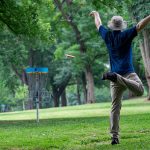Disc golf is a fun and accessible outdoor recreational activity that combines elements of traditional golf and frisbee. As a beginner, it’s essential to understand the basic rules of the game to ensure a enjoyable and challenging experience. In this article, we’ll cover the fundamentals of disc golf rules, providing a comprehensive overview for new players.
Equipment
The most crucial piece of equipment in disc golf is the disc itself. There are several types of discs, each designed for specific purposes:
- Drivers: Fast and long-range discs used for long shots.
- Mid-range discs: Balanced discs for shots between 100-300 feet.
- Putter discs: Slow and accurate discs for short shots.
Other essential equipment includes:
- Disc golf bag: A bag to carry and organize your discs.
- Scorecard: A paper or digital tool to track your scores.
- Tee box markers: Markers indicating the starting point for each hole.
Objective and Scoring
The objective of disc golf is to throw your disc from the tee box towards the target, which is usually a metal basket or “pole hole.” The goal is to complete each hole in the fewest throws possible.
Scoring is based on the number of throws taken to complete each hole. The player with the lowest total score at the end of the round wins.
Scoring Terms
Here are some common scoring terms:
- Par: The predicted number of throws required to complete a hole.
- Birdie: Completing a hole in one throw under par.
- Par: Completing a hole in the predicted number of throws.
- Bogey: Completing a hole in one throw over par.
Basic Rules
Here are the basic rules to get you started:
Teeing Off
Players take turns teeing off from the designated tee box. The player with the lowest score at the end of the round gets to tee off first.
Playing the Hole
Players throw their discs from the tee box towards the target. The disc must come to rest in the fairway or rough before being thrown again.
Out of Bounds
If a disc lands out of bounds, the player must take a penalty throw from the previous position or the designated drop zone.
Lost Discs
If a disc is lost or cannot be found, the player must take a penalty throw from the previous position or the designated drop zone.
Obstacles
Players can throw over or around obstacles, but not through them. If a disc passes through an obstacle, it’s considered out of bounds.
Interference
If a player’s disc is interfered with by another player, animal, or external factor, they can replay the shot from the previous position.
Common Penalties
Here are some common penalties in disc golf:
- Out of bounds: 1-stroke penalty.
- Lost disc: 1-stroke penalty.
- Interference: Replay the shot from the previous position.
Conclusion
Disc golf is a fun and accessible outdoor recreational activity that requires minimal equipment and knowledge of the rules. By understanding the basics of disc golf, you’ll be well on your way to enjoying a challenging and enjoyable game. Remember to always follow course rules, respect other players, and have fun!
FAQs
Q: What is the best way to learn disc golf?
A: Start by practicing your throws and learning the basic rules. Watch tutorials and videos to improve your technique. Join a local disc golf club or play with experienced players to learn more.
Q: What is the most important thing to remember in disc golf?
A: Respect the course, other players, and the environment. Follow course rules, keep the course clean, and be mindful of wildlife and other players.
Q: Can I play disc golf with any type of disc?
A: No, it’s recommended to use discs specifically designed for disc golf. These discs are made with the right materials and weight to provide the best performance and accuracy.
Q: How do I keep track of my scores?
A: Use a scorecard or a digital tool to track your scores. You can also use a disc golf app to keep track of your scores and stats.
Q: What is the best way to improve my game?
A: Practice regularly, focus on your technique, and try to improve your accuracy and distance. Watch tutorials and videos to learn new techniques and strategies.








